
Dublin Cycle Paths
Press
Radical New Plan
Car-Free Day
Cyclists try their luck
Minister
Launches Conference
Plans
DTO Cycle Network
The Law
The Acts & SIs
Links
Government
Interest/Lobby Groups
Reports
The Dundrum
Bypass
Dangerous Designs
| List of Dublin City Council Cycling terms & some explanations: | |
| Cycle Route | Cycle Routes are made up of ordinary road with no reservation for cyclists, 'mandatory cycle lanes', 'non-mandatory cycle lanes', cycle paths and cycle tracks. Most 'cycle routes' contain a substantial element or ordinary road with no adaptation or reservation for cyclists. The term was adopted by City Council spin doctors as it has no legal definition. Typically Cycle Routes operate on a part time basis and must be shared with cars buses and trucks. |
| Cycle Way | Defined under the Roads Act 1993 (Art 68) as "for the exclusive use of pedal cyclists". Most of what is constructed does not fit this definition. The term is never used by local authorities. |
| Mandatory Cycle Lane |
|
| Non-Mandatory cycle lane |
|
| Cycle Facility | Obsolete term, the word 'facility' became embarrassing, so the term 'Cycle Route' was invented. No photo available. |
| Cycle Path |
The sign, pictured here, is not mentioned in the regulations. |
| Cycle Track |
|
| Cyclist Priority Route | See 'Cycle Route'. Cyclists have priority if there are no vehicles on the road at the same time. The term occasionally appears in City Council propaganda but has no legal definition. |
| Cyclist Contra-Flow | 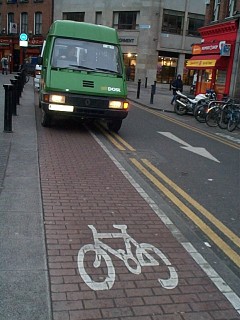 Cycle
lane running against the flow of traffic down a one-way street. Cyclists
have priority unless a motorist wishes to drive along it or park on
it. Cycle
lane running against the flow of traffic down a one-way street. Cyclists
have priority unless a motorist wishes to drive along it or park on
it. |
| Cycle Crossing |  Traffic
light controlled junction which gives priority to motorists and occasionally
permits cyclists and pedestrians to cross. Cyclists should first seek
the permission of any motorist present, before attempting to cross,
as the motorist may not wish to stop at that time.. Traffic
light controlled junction which gives priority to motorists and occasionally
permits cyclists and pedestrians to cross. Cyclists should first seek
the permission of any motorist present, before attempting to cross,
as the motorist may not wish to stop at that time.. |
| Surface Quality | 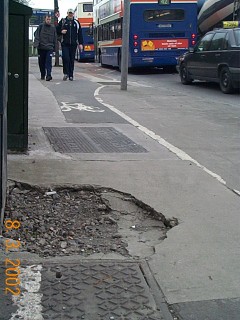 Anything
at all will do, there are no standards. Anything
at all will do, there are no standards. |
| DTO Standards | The Dublin Transport Office published a 'design manual'. These are not legally binding on local authorities. The manual is currently being revised to avoid embarrasing the local authorities who have being applying what they call 'best practice'. |
| Cycle Network | A DTO fantasy. DTO Map here. |
| Cleaning/Maintenance | Only after an accident. |
| 'Best Practice Design' | Term used by the City Council to describe a cycle facility not in compliance with the DTO design standards or statutory regulations. It's a euphemism for 'ad-hoc' or 'whatever'. |
| Key performance indicator | 'Number of km of Cycle Routes Constructed'. |
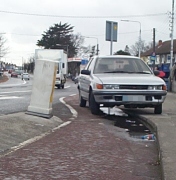 Cyclists
must use these. Cars, bus, taxi, security van drivers and motorcyclists
often use them if they deem their lane is not wide enough. No particular
width, marking or quality is required apart from a continuous white
line to the right.
Cyclists
must use these. Cars, bus, taxi, security van drivers and motorcyclists
often use them if they deem their lane is not wide enough. No particular
width, marking or quality is required apart from a continuous white
line to the right.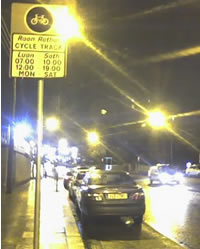 Indicated
by a broken white line to the right. Some motorists mistake these
for hard shoulder. Usage as for 'Mandatory' type above, but parking
is allowed most of the day, all night and on Sundays. The regulations
were amended in 1998 to allow all kinds of motor traffic to use
these if they wished. Cyclists are obliged to use these lanes at
all other times but must give up their place in the track if a motorist
wishes to drive or park in it.
Indicated
by a broken white line to the right. Some motorists mistake these
for hard shoulder. Usage as for 'Mandatory' type above, but parking
is allowed most of the day, all night and on Sundays. The regulations
were amended in 1998 to allow all kinds of motor traffic to use
these if they wished. Cyclists are obliged to use these lanes at
all other times but must give up their place in the track if a motorist
wishes to drive or park in it.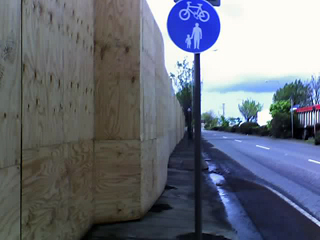 A
footpath where cyclists have been diverted. There may or may not
be markings separating the cycling area from the pedestrian area.
Where present, these may be ignored by pedestrians. Motorists park
on cycle paths to avoid obstructing the road. Cycle paths can be
of any width and may contain waste recepticles and lamp standards.
There is no restriction on opening the surface and no control over
the quality of restoration or cleaning. The design of a cycle path
does not require it to have any exit when it terminates, as it has
already served its principal purpose by removing bothersome cyclists
from the road and inflating local authority statistics for 'km of
Cycle Route Constructed'.
A
footpath where cyclists have been diverted. There may or may not
be markings separating the cycling area from the pedestrian area.
Where present, these may be ignored by pedestrians. Motorists park
on cycle paths to avoid obstructing the road. Cycle paths can be
of any width and may contain waste recepticles and lamp standards.
There is no restriction on opening the surface and no control over
the quality of restoration or cleaning. The design of a cycle path
does not require it to have any exit when it terminates, as it has
already served its principal purpose by removing bothersome cyclists
from the road and inflating local authority statistics for 'km of
Cycle Route Constructed'.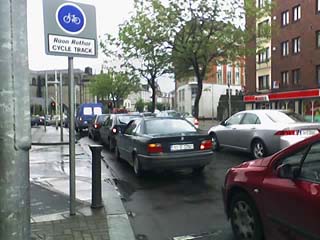 Legally
a "cycle track" means a part of a road including part
of a footway or part of a roadway which is reserved for the use
of pedal cycles and from which all mechanically propelled vehicles
other than mechanically propelled wheelchairs are prohibited from
entering except for the purpose of access.
Legally
a "cycle track" means a part of a road including part
of a footway or part of a roadway which is reserved for the use
of pedal cycles and from which all mechanically propelled vehicles
other than mechanically propelled wheelchairs are prohibited from
entering except for the purpose of access.